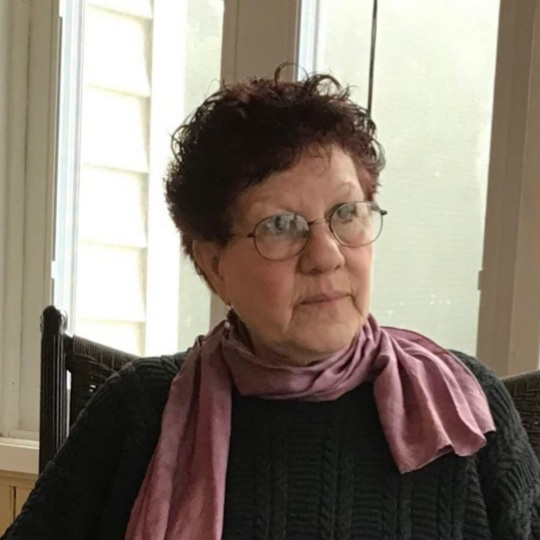
Helena Clare Pittman, one of the Center’s most dedicated teachers, has written, painted, and taught her entire life. In her monthly Helena Writes series, she shares a lifetime of wisdom, one pearl at a time.
In her eighth post, Helena recalls the experience of submitting and publishing her second book, Martha and the Nightbird, and the differences between the book market then and now. Enjoy!
Sugar snow
A beautiful snow is falling, coating everything. Here in this woods, once snow falls, in December or January, it doesn’t melt until the end of April. But this morning’s covering is fresh, fine. It may be what my farmer neighbors call a sugar snow, for the maple sap that will soon run. But I don’t know these secrets, coming from the concrete streets of Brooklyn. I’ll appropriate the poetry of the title today—it looks like powdered sugar.
I didn’t used to feel this way when snow fell here. I dreaded it. I felt trapped. There has been a change over these 24 years. I am more settled here, content.
Submissions as part of the creative process
Martha and the Nightbird was my second book. In those days, the early ’80s, I sent my work everywhere. I opened the Writers Market and went down the list. Caedmon was a house that recorded the classics. I knew it by its recordings of Dylan Thomas, reading his work. Why I submitted work there, I can’t remember, except I know that when I wrote a story, I sent it everywhere. I made up beautiful letterhead stationary, my name and address and a drawing based on the Japanese painter, Katsushika Hokusai’s drawing of an origami crane, coming to life.
I was excited about any story I wrote, and sent them out as fast as I could. I loved the process. I made 25 copies, wrote my cover letters, clipped them to the copies of my stories with beautiful clips I scouted at stationary supply stores—shaped, striped, gold—bought 9×12 manila envelopes by the box. A manuscript, a cover letter, a beautiful clip, then I’d address an envelope to myself, my SASE, and take a stack of these beautiful things to the post office—an act of hope.
Once I had the image of all the inevitable rejections in that pile of envelopes, but I was intrepid.
I’d buy beautiful stamps and mail them off in great hope. That was my process, and part of my art form at the time. Everyone was publishing children’s picture books. Beautiful picture books had once again dawned. It was a gorgeous medium for gorgeous pictures, and the market was good. Beauty and good writing, so fine artists poured into the field. I learned to write by rejection, a glutton for punishment. But my hope couldn’t be defeated for long. It was just so exciting to write and submit my work to the market, a kind of wonderful gambling.
The ride was dazzling. At the beginning, I worked when my infant son was napping, and got up at dawn to work before he got up. I worked late at night. I knew I’d get my work into print; I just knew by my tenacity, I was willing to hammer down the door. Submit stories, get rejected, repeat, repeat, repeat, repeat.
Reconsidering Martha and the Nightbird
By my process, I formed relationships with editors. I wasn’t going away, and some people liked my work and responded. Caedmon had jumped on board the picture book market. They accepted Martha. I loved my editor, who treated me like a star. That was the character of the times. Everyone was excited about beautiful books, and publishers loved artists. It was an expansion for Caedmon, into art. After all they had worked with genuine stars, the greats—writers like Thomas. They’d recorded Sir Lawrence Olivier reading. But Art, then, was of the spell-binding beautiful kind.
I worked on the pictures for Martha for a year, spent hours on each illustration of careful watercolors, a medium I had fallen in love with. Paintings with endless detail. I was a Painter. Illustration became Painting for me for a good 20 years. Martha, I say with no false modesty, was a beautiful book. It was printed in Singapore, a place where color printing was a high art.
The corporate acquisition fever sped up. Caedmon was acquired by Harper. Harper put Caedmon’s list out of print. Martha and the Nightbird fell through the cracks. It was remaindered—copies sold by the lot to the highest bidder. It was never reviewed. I managed to buy a pitifully small number of them, gave them, sold some, and now have three copies.
But because of the internet, Martha lives! So much time has passed that it is listed along with my other books, easily bought, for ninety cents or a dollar. I don’t mind at all. Martha can be acquired through Ebay, Amazon, and all kinds of other places. Browsing the internet this week, for the fun of it, I googled “Martha and the Nightbird.” I found a wonderful review in School Library Journal, I think it was, and other wonderful reviews, some of them recent! I never knew they existed!
Forty years after its publication into seeming obscurity, Martha and the Nightbird is as contemporary as any book. All this has gone to my heart and made me very, very happy. While the old market doesn’t exist, there is a new market, where people buy books, including mine. A dollar, fifty cents, no royalties, this bothers me not at all, an artist to the bone, cells, atoms of me. Money? It always comes. Those reviews knocked my socks off.
The Reward of Rewards
Love of the thing you do is reward in itself.
And here is the kismet of this particular life-event: Caedmon’s editor, the editor I loved, introduced me to my agent. I can only imagine the life-crisis that the selling-off of Caedmon, an American institution, was for my editor. From her loss, and mine, life gave to me an agent who I also love. It is she who is responsible for the success of a number of my books, particularly A Grain of Rice.
I am also, to my bone, cells, and atoms, an optimist. One way or another, hard work is rewarded, whatever people may say in cynical times. And love of the thing you do is reward in itself. The Reward of Rewards. Cliché, but so profoundly true. It makes a life.
I encourage you to hone your craft and put your work out there. One can never imagine the depth of reward—and how it will arrive at your doorstep.
Do you submit your writing? What is the experience like for you? What part of Helena’s story about Martha and the Nightbird resonated most for you? Share with us in the comments!
Related reading: Read the previous Helena Writes posts
Want to receive tips and inspiration like this in your inbox every Sunday morning? Join our email list community! You will receive weekly advice, a year’s worth of weekly writing prompts as a FREE download, and be eligible to participate in our monthly photo prompt contest for a chance to share an original piece of writing with our community of over 1,100 subscribers!
